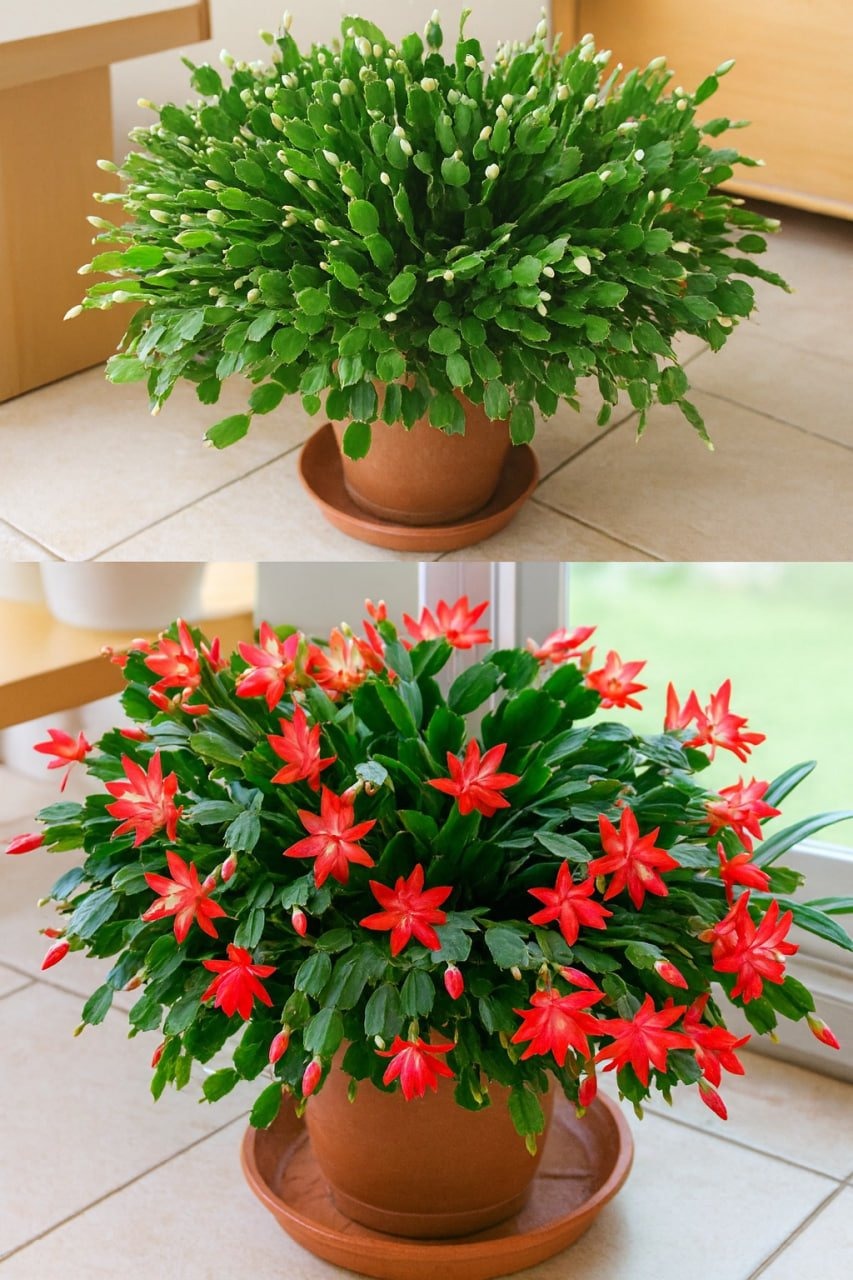Encouraging Your Christmas Cactus to Bloom: A Complete Guide
The Christmas cactus (Schlumbergera), also known as the holiday cactus or Thanksgiving cactus, is a popular houseplant with vibrant, colorful blooms that brighten homes during the winter months.
Native to Brazil, it’s an epiphytic plant, meaning it grows in the wild on trees, absorbing nutrients and water from the air and decaying matter around it. Unlike typical cacti, it’s not suited for extremely dry or desert-like environments, and it thrives in humid, shaded areas with well-drained soil. Its ability to produce show-stopping blooms in red, pink, or white is what makes it a cherished part of holiday decorations.
However, many gardeners and plant owners often struggle with getting their Christmas cactus to bloom. Despite its reputation for being easy to care for, there are times when the plant won’t flower as expected.
This can be frustrating, especially when you’re hoping for a stunning display of color to match the festive season.
In this guide, we’ll share a simple and natural method using common kitchen ingredients to help encourage your Christmas cactus to bloom. This method is not only easy to follow but is also safe and effective. Let’s dive into the steps and helpful tips to ensure your cactus thrives and shows off its beautiful blooms when you need them most.
Ingredients:
Water (Room Temperature)
Room temperature water is ideal for watering most houseplants, including the Christmas cactus. It’s not too hot or too cold, which could shock the roots and hinder the plant’s ability to absorb moisture effectively.
Regular Black Tea
Black tea contains natural tannins, which can be beneficial to plants. Tannins help regulate the plant’s nutrient uptake and promote overall health, encouraging the cactus to focus its energy on blooming.
1 Teaspoon of Sugar
Sugar, though seemingly simple, can act as a source of quick energy for your plant. Sugar feeds the plant, helping it to grow strong and healthy, which is essential for producing vibrant flowers. In this context, the sugar acts as an energy boost, especially during the blooming phase.
Instructions:
Brew the Black Tea:
Start by brewing a regular cup of black tea. Use one tea bag or about 1 teaspoon of loose-leaf tea, depending on your preference. Pour the tea into a cup and let it steep for 3-5 minutes. This allows the tannins and other nutrients to infuse into the water. Be sure not to add any milk or sweeteners to the tea, as these can harm the plant and hinder its growth.
Allow the Tea to Cool:
After the tea has brewed, allow it to cool down to room temperature. It’s important to avoid using hot tea, as this could shock the plant’s roots and cause stress, which might actually prevent blooming. Cooling the tea ensures it’s at the right temperature to hydrate your cactus without causing any harm.
Add the Sugar:
Once the tea has cooled, add 1 teaspoon of sugar to the tea. Stir it well until the sugar is fully dissolved. The sugar serves as a quick energy source for the plant, giving it the extra nutrition it needs to develop healthy buds and flowers.
Water the Christmas Cactus:
Use the cooled tea solution to water your Christmas cactus. Pour it directly onto the soil of the cactus, ensuring that the soil is evenly moistened. Be careful not to pour too much, as this could lead to waterlogging and root rot. If you’re unsure how much to use, a small amount (about ¼ to ½ cup) should suffice for a medium-sized plant.
Repeat Once a Month:
This solution can be applied once a month during the blooming season (late fall and winter). Applying it too frequently could potentially cause harm, as excessive sugar can lead to the growth of harmful mold or fungus in the soil. Therefore, it’s best to stick to once a month during the blooming period.
Tips for Encouraging Blooms:
Provide Proper Light:
Christmas cacti prefer bright, indirect light. Too much direct sunlight can stress the plant and cause it to drop its buds. On the other hand, too little light can inhibit flowering altogether. The ideal spot for your cactus is near a window with filtered light. If you notice that your cactus is getting leggy (with long, stretched-out segments), it may not be getting enough light.
Temperature Control:
One of the key factors in encouraging Christmas cacti to bloom is a slight temperature drop. In their native habitat, they experience cooler temperatures during the flowering season. To simulate these conditions, place your cactus in a cooler room (around 55-60°F or 13-15°C) for several weeks leading up to the bloom cycle. A cooler environment signals to the plant that it’s time to start budding.
Avoid Overwatering:
While Christmas cacti like humidity, they do not thrive in soggy soil. Overwatering can lead to root rot, a common issue that stunts plant growth and prevents blooming. Make sure the soil dries out slightly between waterings. The key is to keep the soil moist but not waterlogged.
Allow a Period of Darkness:
Christmas cacti are photoperiodic, meaning they bloom when they receive the right amount of light and darkness. To trigger the blooming process, your cactus needs a period of darkness each day for about 12-14 hours. If you keep your cactus in a room that’s brightly lit at night, it may not bloom. Consider moving it to a darker area for several weeks before the blooming season starts.
Keep the Cactus Stable:
Once buds begin to form on your cactus, avoid disturbing it. Christmas cacti are sensitive to changes in their environment. If you move the plant too much, it can cause the buds to drop. Once the flowers start to bloom, they’ll last for several weeks, so it’s important to give the plant a stable environment during this time.
Fertilize with Caution:
While Christmas cacti can benefit from a balanced fertilizer during their growing season (spring and summer), it’s best to avoid fertilizing during the fall and winter, when they are preparing to bloom. Over-fertilization can lead to lush green growth without any flowers. If you do choose to fertilize, use a diluted, balanced fertilizer and apply it sparingly.
Why It Works:
The black tea provides beneficial tannins, which help improve the plant’s overall health, while the sugar offers an instant source of energy for the cactus. This combination encourages the plant to allocate its energy towards the formation of buds and the production of flowers. By following these simple steps, you’re providing the right conditions for your Christmas cactus to thrive and bloom beautifully.
Conclusion:
Getting your Christmas cactus to bloom doesn’t have to be a difficult task. By following these simple and natural steps using ingredients you likely already have at home, you can help your cactus bloom beautifully for the holiday season.
Along with this method, ensure that your cactus receives the right care in terms of light, temperature, watering, and feeding. Before you know it, your Christmas cactus will reward you with vibrant, colorful blooms that will make your holiday season even more special. Enjoy the beauty and festivity of your blossoming plant, and share it with family and friends during the holidays!
-
Garlic Butter Beef Pasta
Few dinners hit the sweet spot between comfort, flavor, and ease quite like Garlic Butter Beef Pasta. This dish is rich, creamy, and deeply satisfying, yet simple enough to make on … Read more
-
apple pie biscuits
Here’s a more detailed version of the Apple Pie Biscuits recipe with a total of 17 paragraphs, covering the entire process from introduction to conclusion: Introduction: Apple pie biscuits are … Read more
-
German Cabbage and Dumplings
Few dishes capture the comfort and simplicity of old-world home cooking quite like German Cabbage and Dumplings. This recipe comes from a tradition of making something deeply satisfying out of humble, … Read more



